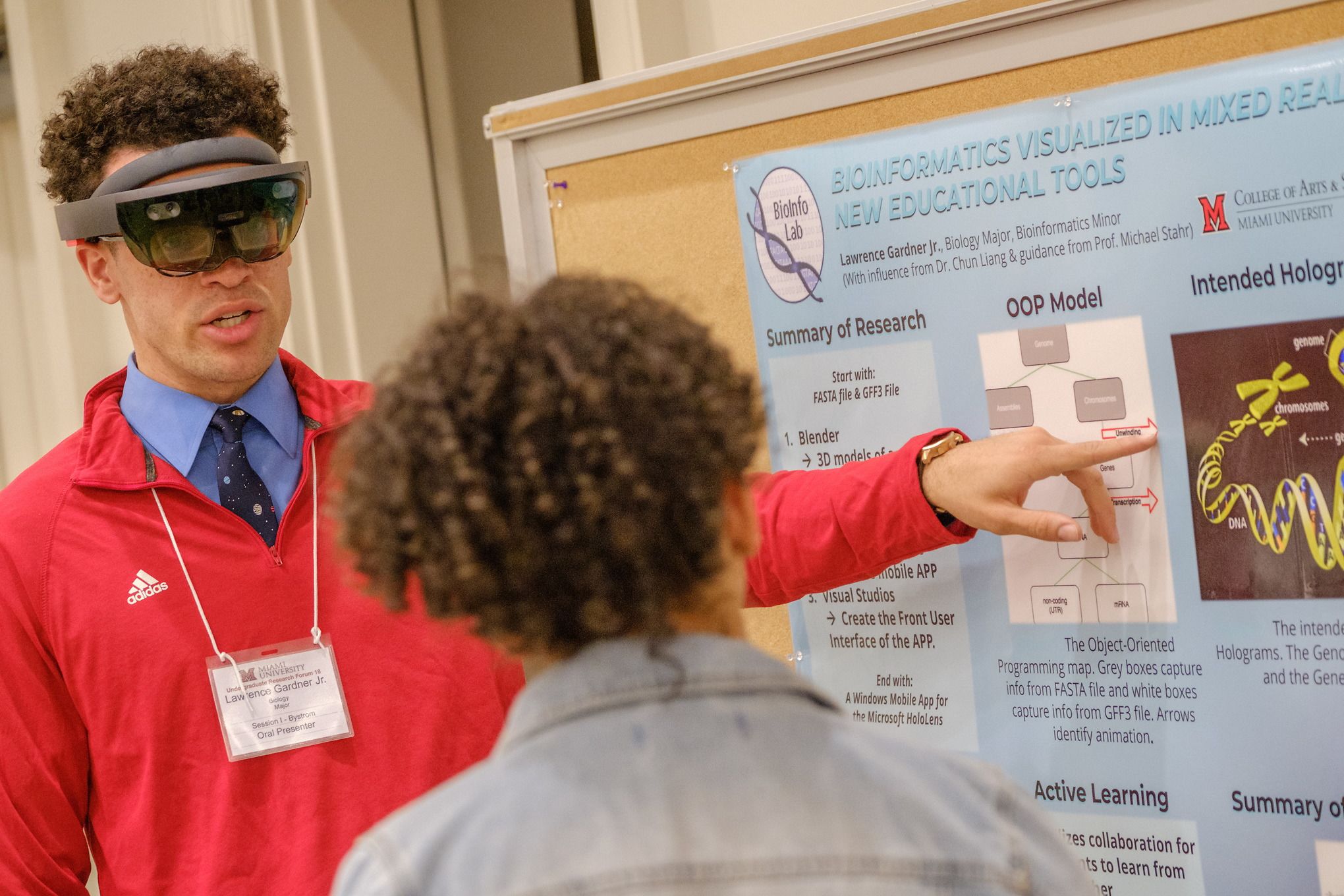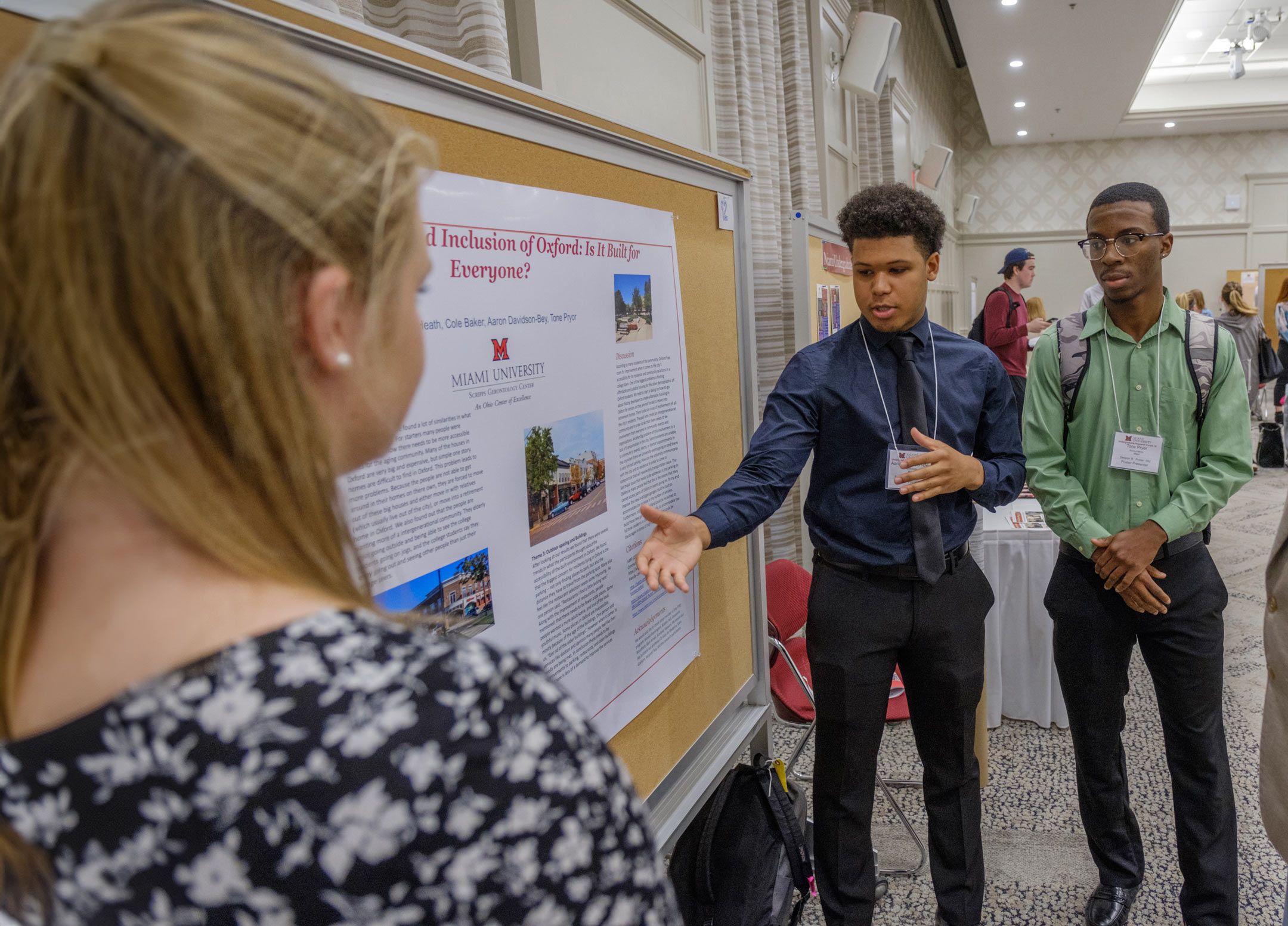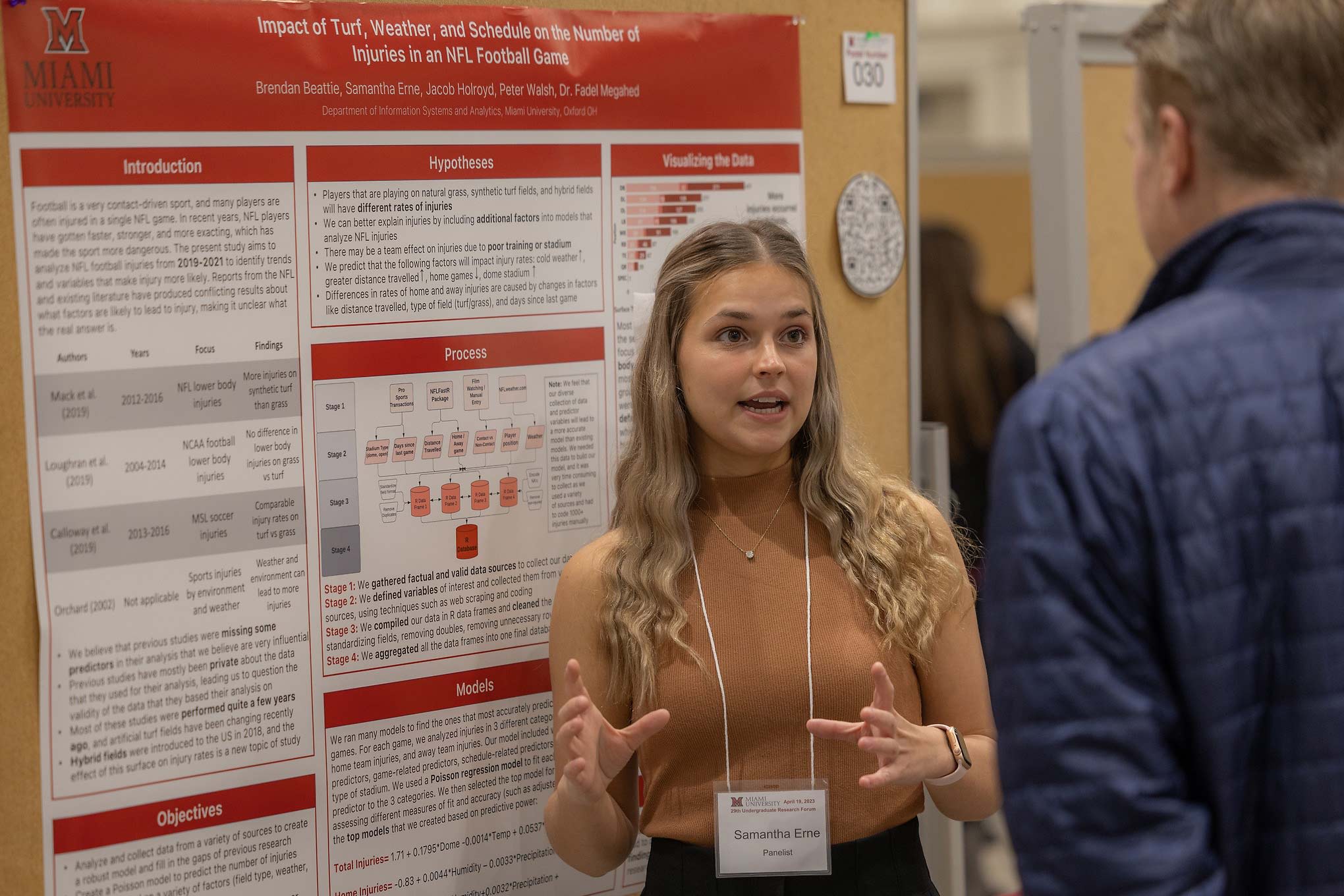Undergraduate student research builds bridges to brilliance
Miami University’s focus on undergraduates embraces a long legacy of research and inquiry

There are not many places where moths, the moon, mental health, esports, and even quantum computers have so much in common.
But they do here, at the Undergraduate Research Forum, where these topics are all part of the interconnected threads that weave together a diverse tapestry of research interests for students at Miami University.
Here, undergraduates talk eagerly about everything from insect population decline and the communication strategies of online gaming communities to the Bosonic properties of quantum particles, and much, much more.
“It’s the best thing that came out of my college career,” said Geology major Katie Caudill, who compared lunar samples from the Apollo 15 mission with meteorites collected from Antarctica.”
“I’ve always been interested in the moon and planetary science,” Caudill continued, “and I got to work with two grad students who invited me to use their samples. And I had never done research before, so it’s been very rewarding.”
The forum is where students get a unique opportunity to publicly present research and findings from in-depth projects born from class projects, independent studies, and meaningful interactions with faculty mentors.
This year also celebrates the forum’s 30th anniversary, and it continues to build upon a long and enduring legacy that encourages undergraduate participation.
“It’s definitely a strength,” said Joyce Fernandes, director of the Office of Research for Undergraduates and professor of Biology. “Miami is invested in undergraduate education, and supporting an engagement in undergraduate research is part of that mission. Every faculty member here knows there is an emphasis on undergraduate education and they understand the benefits of involving undergraduates in research.”
A legacy of research and inquiry
Miami University emphasizes undergraduate research as a core part of the student experience and it’s a mission that goes much deeper than the Undergraduate Research Forum itself, which is merely the university’s largest and most visible student research event. Because students here have many ways to get involved.
The First Year Research Experience (FYRE) program, for example, is designed to jumpstart student involvement in research and inquiry almost as soon as they set foot on campus. And the Undergraduate Summer Scholars program for sophomores and juniors provides approximately 100 slots for a 9-week mentored research experience.
Students are also encouraged to reach out to faculty directly, to inquire about any projects that may align with their interests. Whatever they may be. Which is precisely how Camryn McClelland, a Zoology and Sustainability major, got involved.
“I personally have just really liked moths for a long time,” McClelland said. “And I had Dr. David Russell for a bio course my freshman year. He mentioned that he was doing moth research, and I was like, ‘Oh my god. I need to get in that lab!’”
McClelland’s project at the forum focused on the biomass decline of flying insect populations, and it was just one of over 200 presentations that featured the accomplishments of more than 345 undergraduate students.
However, if you count all the students who are engaged in one-to-one research projects with faculty across campus, that number jumps to around 2,000.
But even still, this is “just the tip of the iceberg,” Fernandes said. Because when you consider courses that engage students in the process of research, nearly 12,000 enrollments were identified in the 2022-23 academic year that also leverage research-based work in some way.
And it’s not only for those in the hard sciences either.
Students interested in the social sciences and humanities are equally involved. And Pepper Stetler, associate director of the Miami University Humanities Center, is always encouraging students to reframe their traditional notions of what “research” means.
“It’s very easy for students to imagine what science looks like,” Stetler said. “Maybe it’s somebody pipetting stuff into tubes in a lab. And with humanities research, they might think of somebody in an old library with an old book from an archive. And it can look like that. But it can also be interviewing people about something that's important to them. Or asking social justice questions.”
“We don't usually show our research through charts and figures and statistical information,” she said. “We use stories to explain something about the world, and that’s the crux of humanities research.”


A bridge between world problems and real solutions
And this connection to the world – the much wider one into which most of these students will soon be headed – is key. Because the skills that they build as the research process unfolds are invaluable in today’s world.
It’s not only a chance to learn about data analysis and visualization, teamwork and collaboration, about persevering through unexpected obstacles and clearly communicating complex ideas. It also teaches them to ask important questions, draw relevant conclusions, and find meaningful answers to pressing problems. And it helps them understand how to apply this process to meaningful issues that matter.
“When you are out there in the world, you are drawing from all different disciplines,” Fernandes said. “And having done undergraduate research, it trains our students to be prepared for that integrative approach. Let's say you get on a team that's building a bridge, you need to test the soil. You need to know about your construction materials and about architecture. You need someone who can understand multiple perspectives and pull it all together.”
And the students here certainly do. Their interests always come together in unique and fascinating ways.
Like how Anthropology major Brett Novits combined his passion for esports, online gaming, and human behavior to learn how different communities rely on specialized forms of communication to connect and thrive.
Or how Lana Money and Briana Calloway combined their interests in Political Science and Psychology to understand how mental health stigmas affect the services that historically underrepresented populations often receive.
In fact, the possibilities are virtually limitless. Some may even impact important innovations that could stretch far into our collective future, and Hannah McDougall’s plans are no less ambitious.
As an Engineering, Physics, and Computer Science triple major, McDougall explored quantum interface effects. Her project used beam splitters to investigate the light-matter interactions that occur on an atomic scale. Her goal being to better predict and control how photons interact.
“This is the basics of quantum information, and how we can store and process it,” McDougall said. “I want to build quantum computers, and having a greater understanding of this is going to make the next generation of quantum computers possible.”
“So doing research in this field, and learning about the different aspects, and the basics behind it helps me to know what questions to ask when I do get into the field,” she said. “And creating these connections through Miami has put my foot in the door.”
This custom content is sponsored by Miami University and developed by Inside Higher Ed's sponsored content team. The editorial staff of Inside Higher Ed had no role in its creation.


